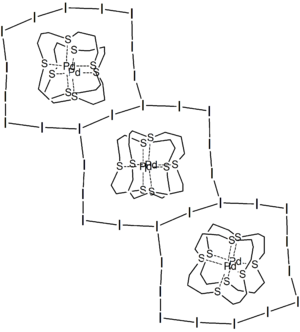Utente:Grasso Luigi/sanbox1/Polioduri
I polioduri sono una classe di anioni polialogeni formati solo da atomi di iodio. Quello più comune e più semplici è lo ione triioduro, I−3. Altri noti e più estesi sono [I4]2−, [I5]−, [I7]−, [I8]2−, [I9]−, [I10]2−, [I10]4−, [I11]3−, [I12]2−, [I13]3−, [I16]2−, [I22]4−, [I26]3−, [I26]4−, [I28]4− e [I29]3−.[1]
Sintesi
[modifica | modifica wikitesto]The polyiodides can be made by addition of stoichiometric amounts of I2 to solutions containing I− and I−3, with the presence of large counter-cations to stabilize them. For example, KI3·H2O can be crystallized from a saturated solution of KI when a stoichiometric amount of I2 is added and cooled.[2]
Struttura
[modifica | modifica wikitesto]

Polyiodides are characterized by their highly complex and variable structures, and can be considered as associations of I2, I−, and I−3 units. Discrete polyiodides are usually linear, reflecting the origin of the ion. The more complex two- or three-dimensional network structures of chains and cages are formed as the ions interact with each other, with their shapes depending on their associated cations quite strongly. The table below lists the polyiodide salts which have been structurally characterized, along with their counter-cation.[3]
| Anione | Contro-catione | Descrizione strutturale |
|---|---|---|
| [I3]− | Cs+ | lineare |
| [I4]2− | [Cu(NH3)4]2+ | symmetric linear array of iodine atoms[4] |
| [I5]− | [EtMe3N]+ | V-shaped with polymeric layers |
| [EtMePh2N]+ | V-shaped with isolated [I5]− ions | |
| [I7]− | [Ag(18aneS6)]+ | an anionic network derived from a primitive rhombohedral lattice of iodide ions bridged by I2 molecules |
| [I8]2− | [Ni(phen)3]2+ | regular anionic shapes, can be described as [I−3·I2·I−8] or [I−3·I−5] |
| [I9]− | [Me2iPrPhN]+ | 14-membered ring tied by two I2 bridges to give 10-membered rings |
| [Me4N]+ | non-octahedral, but a twisted "h"-like arrangement of I−3 and I2 units | |
| [I10]2− | [Cd(12-crown-4)2]2+ | twisted ring configuration with two I−3 units linked by two I2 molecules |
| [I11]3− | [(16aneS4)PdIPd(16aneS4)]3+ | 14-membered ring (9.66 × 12.64 Å) around the complex cation, with the rings interlink further to give an infinite
2D sheet |
| [I12]2− | [Ag2(15aneS5)2]2+ | extended 3D spiral superstructure supported by Ag–I bonds and weak I···S interactions |
| [Cu(Dafone)3]2+ | planar configuration | |
| [I13]3− | [Me2Ph2N]+ | consists of zigzag chains of I− and I2 |
| [I16]2− | [Me2Ph2N]+ | centrosymmetric arrangement of [I7−·I2·I7−] |
| [iPrMe2PhN]+ | the anion forms 14-membered rings catenated by I2 molecules, which further link into layers with 10- and 14-membered rings | |
| [I22]4− | [MePh3P]+ | \two "L"-shaped [I5]− units linked by an I2 molecule and completed by two end-on [I5]− groups |
| [I26]3− | [Me3S]+ | consists of [I5]− and [I7]− ions with intercalated I2 molecules |
| [I26]4− | Cp*2Fe+ | an anionic network derived from a primitive cubic lattice built from I− ions, with I2 bridges on all edges and systematically removing 12⁄{{{2}}} of the I2 molecules |
| [I29]3− | Cp2Fe+ | an anionic 3D network with a cage-like structure of [{(I−5)Template:1/2·I2}·{(I2−12)Template:1/2·I2}·I2], with [Cp2Fe]+ ions interacting with the anion in the cavities |
| [I∞]δ− | Pyrroloperylene+• | Infinite polyiodide homopolymer.[5] |

Note
[modifica | modifica wikitesto]- ^ Chapter 17: The group 17 elements, in Inorganic Chemistry, 3rd, Pearson, 2008, p. 547, ISBN 978-0-13-175553-6.
- ^ Potassium triiodide, in Handbook of Preparative Inorganic Chemistry, vol. 1, 2nd, New York, Academic Press, 1963.
- ^ R. Bruce King, Chlorine, Bromine, Iodine, & Astatine: Inorganic Chemistry, in Encyclopedia of Inorganic Chemistry, 2nd, Wiley, 2005, p. 747, ISBN 9780470862100.
- ^ Synthesis, Structure, and Bonding in Polyiodide and Metal Iodide–Iodine Systems, in Chem. Rev., vol. 103, n. 5, 2003, DOI:10.1021/cr0204101.
- ^ Infinite Polyiodide Chains in the Pyrroloperylene-Iodine Complex: Insights into the Starch-Iodine and Perylene-Iodine Complexes, in Angewandte Chemie International Edition, vol. 55, n. 28, 4 July 2016, pp. 8032–8035, DOI:10.1002/anie.201601585.
Altri progetti
[modifica | modifica wikitesto]